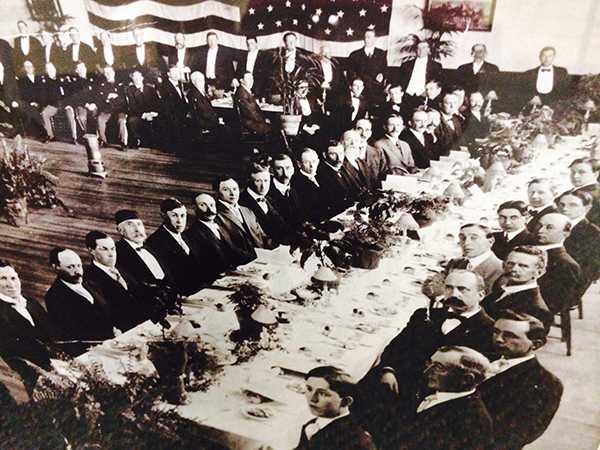With a population of just over 3,000 in September of 1889, the Northern California town named Napa had little to attract much outside attention. Surrounded by farm fields, the tiny community possessed dirty streets which were dusty in dry weather and very muddy in wet weather. Wooden sidewalks were generally uneven and posed a challenge to those intent upon walking on them.
Other than family-owned businesses, there were few job opportunities. Even some basic necessities of the time were not to be found in the community. George M. Francis, owner, publisher and editor of the Napa Register for 19 years at the time, decided enough was enough, and having been appointed Napa postmaster by directive of President Chester Arthur, Francis had sufficient contact with his fellow townspeople to realize there was growing discontent with conditions.
Thus, Francis called a public meeting at the local courthouse on September 30, 1889. Much to the delight of all concerned. 80 Napans came to the gathering. E.D. Beard, local merchant was elected temporary chairman and as a first item of business appointed Frances, Robert Corlett A.W. Norton, the Reverent Richard Wylie and Henry Brown to serve as a committee which would formulate a plan for the organization.
After the committee adjourned to another room to ponder its mission, the remainder of those assembled for the meeting agreed with a motion that officers be elected to serve for the next 12 months. Named by acclamation were Beard, president; A.E. Holden, vice-president, L.E. Norton, secretary; C.R. Gritman, treasurer, Henry Brown, C.B. Seeley, A.W. Norton and W. J. McCullum, executive committee.


Before Beard adjourned the session, it was agreed that the next meeting would concentrate on the “reorganization of our city government” as well as considering recommendations for the special committee deliberation at the time in the adjoining room.
October 7 proved to be a meaningful occasion for those attending the next meeting – and that included most from the initial gathering.
By almost unanimous vote it was agreed that the new organization would be named the Napa Improvement Society.
A committee was appointed to speed the process required to have Napa streets sprinkled and a way to finance the effort. Recommendations of the special committee that there be some reorganization of city government were approved and a new group as named to formulate a plan to accomplish the aim without legislative approval.
At a meeting November the first, bills were presented for payment. There was immediate approval for the expenditure of $2.55 to cover the expenses.
At the same time, a plan was adopted for sprinkling the streets the following summer and a special subcommittee was formed to study means of improving the “heavily traveled” roads leading to the local cemetery and the Napa’s principal source of employment, the state-financed asylum just south of town.
By December 2, Improvement society leaders were calling on the county supervisors to adopt a plan of action for needed area road improvements; three months later, at an estimated cost of $2,500, such a plan was authorized. At that time, just about everyone in positions of authority recognized that the Improvement Society was ”Napa’s Voice.”
By 1896 it was decided that greater emphasis should be placed on the local economy, and with that decision came a change of name from Improvement Society to the Napa Board of Trade, Eight years later leaders thought it more realistic to call their organization the Napa Chamber of Commerce and that designation became official January 25, 1904.
The adopted bylaws declared the primary objective of the Napa Chamber of Commerce would be “to bring the people of Napa together as an organization that as such may better protect the individual and collective interests.” The document specified:
“For an organized effort to promote the best interests of the City and County of Napa commercially (the Chamber) by inducing immigration and encouraging new manufacturing industries, increased transportation facilities and giving moral support and encouragement to the several departments of the city and county governments whereby extensions and improvements shall be encouraged…”
Bylaws declared the at “any person of good moral character can become a member of the organization.” There would be no “joining fee,” but once members were approved, they would be assessed monthly dues of fifty cents. Six standing committees would operate within the chamber: Manufacturing, Immigration, Waterways & Transportation, Streets & Highways, Visitor & Reception, and Advertising.
At the turn of the century Napa’s first major effort to attract tourists was launched in Ogden, Utah – railway center of the west – where several thousand leaflets were distributed to passengers boarding trains for San Francisco.
Much has been written about the earthquake of 1906 which resulted in the deaths of 503 San Francisco area residents, injuries to thousands of others and more than $350 million in property damage. Yet, the quake and subsequent tremors recorded April 18 and 19 were also felt in the Napa Valley.
Although there were no deaths and only a few minor injuries recorded within Napa County, there was extensive – if not costly – property damage in the Napa Valley.
But, despite the scars from the quake locally, Napans rallied to provide assistance to those most in need – the people of San Francisco as well as friends and relatives in Santa Rosa and Sonoma County. Chamber of Commerce President I.J. Evans had no difficulty when he issued a call to the Napa business community and residents to provide accommodation for earthquake victims and needed supplies for others where damage was most severe. About 200 San Franciscans were housed in private homes in Napa.
The Napa Chamber of Commerce collection points received large quantities of food, blankets and clothing or shipment to San Francisco and Santa Rosa. Some Napans who happened to be in San Francisco at the time of the earthquake, provided eyewitness accounts of the disaster to local newspapers. Napans in San Francisco also helped arouse public concern regarding the earthquake. Attracting major attention locally was earthquake damage in the central business district of Napa, particularly a badly damaged outer wall at the Migliavacca Building and structural damage at the Uncle Sam Wine Cellar on Main Street. Major cracks developed in the caves at the Beringer Winery at St. Helena.
The Great Depression of the 1930’s had a severe impact on Napa just as was the situation in hundreds of other California communities. The Napa Chamber of Commerce joined with local church and welfare groups to lessen the impact of the economic crisis locally. But, the Chamber had problems of its own.In June 1, 1939, directors issued a statement noting their concern over the loss of memberships because of business failures in the community. “It is hard to get new members because business conditions are not good, collections are slow and businesses cannot see the way to shoulder any additional expense,” a Chamber release stated. In order to help customers remain in business, the Rough Rider clothing company in Napa extended generous amounts of credit to its Bay Area customers. Many acknowledged that they were saved from economic disaster by the gesture.
Even before the United States entered World War II on December of 1941 the Napa Chamber of Commerce had formulated a program to support the nation’s armed forces and defense efforts. Napans were asked to make living space available to workers arriving from across the nation to work at the expanding Mare Island Naval Shipyard and Benicia Arsenal.
In January of 1942 the Chamber gathered local donations for British (War) Relief and directors authorized the use of Napa Chamber of Commerce premises for the entertainment of American soldiers then temporarily camped at he the Nap fairgrounds. Chamber directors were asked to help locate and emergency location for an auxiliary field in conjunction with Alameda Naval Airbase. Yountville had been suggested as a possible site.
In December a New Years Eve dance was planned by the local VFW auxiliary at the Napa Chamber of Commerce hall for American servicemen en route to the war zones. Large numbers of Chamber members and their families left the community for active duty in the armed forces. The Chamber cooperated with the National authorities to help locate sites for federal housing projects to accommodate the ever increasing number deference industry workers moving to the Napa-Vallejo area.
Peter Gasser, Chamber president during the war years, frequently presented checks and other forms of assistance to the USO, American Red Cross and other agencies supporting the war effort.
Napa Chamber of Commerce personnel helped generate cards, letters and packages form local townspeople for servicemen overseas. Napa families were encouraged to “dial a sailor” and other military personnel assigned to the area for home hospitality and meals.
Historical Timeline
Napa Chamber Timeline – 1950-1980
1950s
- A 1950s Napa Chamber of Commerce brochure stated: “Characteristics of this community are definitely industrial, with an estimated employment of 7,265. Approximately 1400 persons are employed in Government establishments in the community, including those working at two large Government hospitals. Food processing, garment manufacturing and glove manufacturing establishments hire a large number of women…..Wholesale and retail trade, manufacturing and service industry are the leading employers.”
- 1955 Chamber started Business-education day, a program in which Napa teachers are taken through city businesses and factories and later entertained at luncheon.
- Jan. 1956 NSJ article stated the Senator Nathan Coombs would be attending the Chamber’s annual dinner and installation of officers. Bert Stewart, public relations head of the National Automobile Club was the principal speaker. William Blanckenburg became new Chamber president.
- November 1954 article Chamber announces it will be conducting a Treasure Hunt contest to attract additional industry to the Napa area. $1000 will be awarded for top suggestions on industrial possibilities.
- June 1957 Chamber Bulletin reports on the results of a questionnaire filled out at the Industrial Conference and by chamber members. In reply to the question, What steps do you recommend to expedite industrial development? 64% indicted that they felt the need for more effective planning for industry, more favorable community attitudes toward industry and the rendering of technical and promotional assistance by the C of C to industrial developers. 45% indicated that more funds should be spent for increased promotion.”
- July 1959 Chamber sponsors first Sidewalk (Sale) Day
- Oct. 1959 Napa County officials and civic leaders gathered at Silverado Country Club as guests of Napa Chamber to welcome the new district and division offices of the Pacific Telephone and Telegraph Co.
1960s
- 1961 Napa Junior Chamber of Commerce was started
- 1961 Chamber Annual Report: “ A consumer education program was carried out with splendid cooperation y the press and radio Many different unethical or fraudulent operations were publicized, the Napa CC won statewide recognition for its efforts in this field by the State Office of Consumer’s Council.” Also reported: “All new residents to Napa re provided a complete kit of information regarding schools, history of the area, organizations, churches and other related matters, in addition to the membership directories.”
- 1965 Chamber publications reports: “Some 200 business and community leaders decided to prove their intentions of wanting more industry by cold cash. GNID, Greater Napa Industrial Developers, was incorporated in 1962 with an aggregate of all shares of $250,000 for the express purpose of buying land and / or building facilities for a prospective industry. The corporation was set up so as to be able to work with the Small Business Administration, if need be, for the purpose of obtaining additional capital.”
- 1964 Chamber mailed promotional material on Napa County to areas throughout CA, the nation and to foreign countries.
- 1963 Annual Report of Chamber: Chamber helps both businesses and residences during the emergency flood in Jan. [check flood folder?]
- Jan. 1965 NR article “Leadership Sometimes Lacking in Community Affairs: Marshall” stated that the “Directors of the Napa Chamber of Commerce agreed informally yesterday to take a more decisive role in community affairs.” Problem areas included: water, sanitation, better street lights, fair business practices, beautification of the Napa River, good schools, low taxes, improved recreational facilities, art, music and drama, the ball part at Napa Fairgrounds….!!!
1970s
- April 1970 the Chamber passed a “Resolution Relative to the Truman-Hobbs Act” to be sent to several local and state officials and organizations requesting the “establishment of a high priority on the application for Truman-Hobbs funds and construction of the improvements at the earliest date to correct these [see actual resolution, copy in 1970-74 Chamber folder] obstructional structures on the Napa River…”
- 1971 Feb. “the Chamber assisted the city council in its court battle over the urban renewal project, and both agencies were successful in seeing a suit tossed out of court that would have halted the needed civic redevelopment proposal.”
- Oct. 1972 “A chamber Ambassadors Club was formed, with chamber directors appointed to officiate at special civic functions and occasions.” Chamber directors “reaffirmed their stand on the airport master plan and endorsed a facility that could accommodate medium sized jets with the next 20 years.”
- May 1973 “The chamber continued its “A Day With Your Legislator” program last May and took 15 local students to Sacramento to learn first hand the inns and outs of CA government.”
- June 1973 “Good and bad points associated with population growth were tackled by a chamber panel of experts in July. Upshot of the affair was a city policy change establishing a “slow growth” philosophy within the framework of the city’s general plan.”
- May 1974 “Chamber directors fervently backed the long-delayed southern crossing project, and in May began to circulate petitions directed at the California Highway Commission relative to the need for project funding.”
- May 1976 Chamber director went on record supporting the formation of a special Narcotics Enforcement team. They also took stands opposing legislation giving government employees the right to strike and supporting legislation requiring a two-thirds vote of the legislature to raise taxes.












